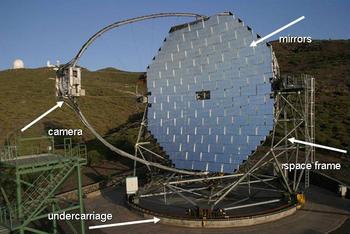MAGIC
Skip navigation and go to main content
- Home
- General Information
- Science with MAGIC
- MAGIC members
- Maintenance

Technical implementations » Mount
MAGIC uses and Alt-Azimuth mount, running on six bogeys on a circular rail. The pointing direction is varies by rotation about two perpendicular axes, a vertical axis (azimuth) and a horizontal axis (elevation). Undercarriage and bogeys are steel constructions with a space frame of 17 m diameter. They carry the mirror support structure, made from carbon fiber reinforced plastic tubes, based on a rod-and-knot system without welds by German construction design company MERO. The camera is mounted on a single aluminium tubular arc, secured against transverse movements by pre-stressed steel cables.
The total moving weight in azimuth 64 tons, in altitude 20 tons. Azimuthal (altitude) movement is achieved by two (one) electric driving motors, each with a maximum output of 11 kW. Re-orientation of the telescope to any point in the observable sky is possible in about 40 seconds with average speed. In case of GRB follow-up observations a maximum speed of about 7 degrees per second can be achieved, making a positioning in less than 25 seconds possible. Angular positions are measured by 14-bit shaft encoders, and cross-checked by a starguider camera mounted in the center of the mirror dish.

